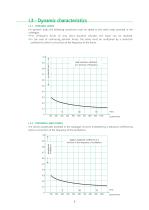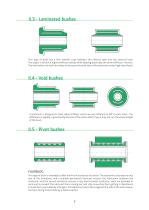Catalog excerpts

Flexible Bushes Innovation for your future
Open the catalog to page 1
Flexible Bushes 1.1 The operation of a flexible bush 3 II - PRINCIPAL TYPES OF FLEXIBLE BUSHES III - OUTER SLEEVE AND CENTRE AXIS III.2 Protection during storage 10 IV - THE SELECTION OF A FLEXIBLE BUSH 11 VI - CATALOGUE OF FLEXIBLE BUSHES 12/21 Please see current price list for availability of items. We reserve the right to modify the design and manufacture of the products and materials described in this catalogue. The pictures of the products are supplied for information only. - the contract signed by both parties, or the purchase order and the acknoledgement of receipt, - eventualy,...
Open the catalog to page 2
I - GENERAL I.1 - The operation of a flexible bush A flexible bush has an elastomeric element enclosed between an outer sleeve and a centre axis intended to replace a greased bush. The improvements achieved in industry due to the use of elastic bushes have been justly compared to the progress achieved in the past by the use of ball joints. In fact, the improvements achieved by the latter by reducing friction and play considerably and reducing wear an noise, have been taken even further by elastomeric rubber bushes which eliminate play completely and isolate high frequency vibrations.
Open the catalog to page 3
I.2 - Static characteristics I.2.1 - RADIAL CHARACTERISTICS The application of a radial force FR causes an elastic eccentricity X by compression of the elastomer on one side and stretching of the other side. The bush is characterised by the permissible radial static force and by the corresponding eccentricity. In practice, the permissible radial static forces are estimated by taking the stress rate on the surface area S of the rectangle which represents the projection of part of the elastomer which is in contact with the internal tube. FR FR Stress rate = t = ___ = _____ S d1 x l l The...
Open the catalog to page 4
I.2.3 - AXIAL CHARACTERISTICS When the external tube is fixed, the application of an axial force Fa on the internal tube will cause an elastic displacement “y” parallel to the axis of the bush, by shearing of the elastomer. The bush is characterised by the permissible axial load and by the corresponding elastic displacement. In practice, the permissible static axial loads are estimated by taking the stress rate at the internal tube. Fa = π x d1 x l x t where d1 and l are in cm and Fa in daN and t is in daN/cm2 The permissible static deflection is a function of the radial thickness of the...
Open the catalog to page 5
I.3 - Dynamic characteristics I.3.1 - DYNAMIC LOADS For dynamic loads, the following corrections must be added to the static loads provided in the catalogue: G For infrequent forces of very short duration (shocks), the loads can be doubled. G In the case of continuing periodic forces, the loads must be multiplied by a reduction coefficient λ which is a function of the frequency of the forces. load reduction cœfficient as a function of frequency accidental load I.3.2 - TORSIONAL AMPLITUDES The torsion amplitudes provided in the catalogue must be multiplied by a reduction coefficient µ which...
Open the catalog to page 6
II - PRINCIPAL TYPES OF FLEXIBLE BUSHES II.1 - Simple bushes FLEXIBLOC (fig. 1) - FULLY BONDED This is a bush made up of 2 concentric tubes between which of elastomer is bonded. Under the effect of external forces or torques, the relative movement of the tubes will cause an elastic deformation of the elastomer. By consulting the service conditions, a bush should be chosen which will remain within its elastic operational limits. SILENTBLOC (fig. 2) - PRESTRESSED This is a bush made up of 2 concentric tubes between which a ring of “adhérite®” elastomer is inserted by force. Under the effect...
Open the catalog to page 7
This type of bush has a thin metallic tube between the internal tube and the external tube. The object is to have a higher stiffness radially while keeping practically the same stiffness in torsion. The lamination of a bush also helps to decrease the work rate of the elastomer under high radial loads. A void bush is designed to have radial stiffness which are very different at 90° to each other. The difference in rigidity is governed by the size of the voids, which mayor may not run the whole length <<<<,<<<<^<<<<<,<<<<^<<<<<,<<<<s<< <<<<,<> This type of bush is intended to offer minimum...
Open the catalog to page 8
SPHERIFLEX: In this bush, the outer sleeve and centre axis are spherical, which enables the bush to resist relatively high radial and axial loads and to obtain a circular rigidity which is independent of the axis of rotation. “PRESTRESSED BUSHES” with turned down sides: For the same dimensions, this type of bush provides a radial load capacity which is superior to that of the classic “prestressed”. In addition, versions of relatively short length permit conical movement more easily (reduced torque and increased angle). CONICAL BUSH: This takes the form of a rubber sleeve whose external...
Open the catalog to page 9
III - OUTER SLEEVE AND CENTRE AXIS III.1 - Materials used In general, the outer sleeve and centre axis of flexible bushes are made of: • Mild steel or polyamide for the external outer sleeve. • Medium carbon steel for the centre axis. The reason for the difference has to do with the method of fixation onto the internal armature, which is usually done by forcing from one end. The armature must therefore be both strong and not too thin, to avoid buckling. III.2 - Protection during storage To avoid corrosion of the steel parts, the parts are protected by a layer of phosphate which gives them a...
Open the catalog to page 10
IV - THE SELECTION OF A FLEXIBLE BUSH In order to specify a bush correctly for a given application, the following criteria must be determined: Basic data For each of the 4 characteristics of the part (axial, radial, torsion or conical), the following values must be taken into account: - The maximum static values (of force and/or of deflection) to which the part is subjected. - The maximum dynamic values and their frequencies. Fundamental parameters Depending on the application, determine from the basic data the major fundamental parameter(s) which govern the choice of the bush to be used....
Open the catalog to page 11All PAULSTRA catalogs and technical brochures
-
STRAFLEX®
2 Pages
-
JUBOFLEX® TYPE S
2 Pages
-
JUBOFLEX®
2 Pages
-
MPP®
4 Pages
-
MINIFLEX®
4 Pages
-
V402-MG
2 Pages
-
PDM-1000-01 / PDM-2000-01
1 Pages
-
V43 / V44 / V45 / V46
2 Pages
-
POLYURETHANE FOAM
2 Pages
-
VIBSOL ®
2 Pages
-
METALLIC CUSHIONS
4 Pages
-
PAULSTRADYN®
4 Pages
-
RADIAFLEX®
4 Pages
-
GENERAL CATALOGUE INDUSTRY
380 Pages
-
Dynamic sealing
35 Pages
-
Flexible couplings
54 Pages
-
Metal Mounting
74 Pages
-
Flexible Mounts
164 Pages
























